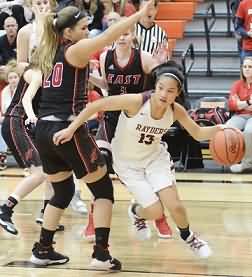Positionless Basketball?
From the Coach’s Clipboard Basketball Playbook"Helping coaches coach better..."
Disclosure: This page contains affiliate links, which means that Coach's Clipboard receives a small commission (at no cost to you) if you make a purchase using these links.
You hear a lot about "positionless" basketball these days. The concept is a good one, but like most things in life, not a panacea for everyone. So let me discuss...
What is positionless basketball?
Positionless basketball means that instead of players playing certain positions (e.g. point guard, shooting guard, post player, etc), all players can play at any place on the court. A "big" can play on the perimeter and smaller players can post up. No-one is constrained to stay within his/her conventional boundaries on the floor. Having players with similar skill-sets, good spacing and passing are paramount.
You see this more at the pro and elite college levels, where you have 12 good players who have the skill-sets to play anywhere. A big can go outside and shoot the 3-pointer, and tall athletic guards can take the ball inside, dunk and post-up.

But what about at the youth and high school levels?
At the youth level
I agree with skills trainers that all youth players should be taught all skills, not just those skills related to either post or perimeter play. Bigger kids should not be taught to just hang around the basket. There's no reason they can't do dribbling and ball-handling drills, learn to shoot from outside and learn to attack the defender on the perimeter. All players should develop those skills as well as passing, screening and cutting, and defending both inside and on the perimeter.
Youth coaches should spend the majority of their practice time teaching fundamentals - focus on "players, not plays". Developing players, not winning games, should be the primary focus at the youth level. You can put them in a positionless offense such as a simple version of the "Read and React" offense, a simple 5-out offense, or 4-out offense, where all players move about in all of the spots on the court.
But what about at the high school level?
Here's where I'm going to differ with promoters of the positionless game. The positionless concept is great at the pro, elite college, and elite AAU levels when you have 12 thoroughbreds who can all play. For most high school coaches, this is not the case.
We have had some really good teams over the years with some really good post players and some really good guards. But looking back at those teams, there is no way that most of our very best post players would have had success on the perimeter, often because of lack of quickness (not dribbling or shooting skills). And some of our smaller guards who were great shooters and could handle pressure, would not be able to post up inside.
Rather than 12 thoroughbreds, most high school coaches have a hodgepodge of players of varying sizes and skill sets. You can't play a 6'5" 280-pound slug on the perimeter, and you can't have your skilled, quick 5'6" guy spend much time inside. Even players of similar sizes often do not possess the same skill sets - some can shoot and some can't, some can attack with the dribble and some can't, etc.
This is even true at the pro and college levels. Most post players are able to step out to the arc and make some shots, but many (not all) can't beat their defender off the dribble.
In high school, teams often have a handfull of skilled players, and a bunch of "role players" who need to find their niche, where they can help the team. Role players are usually not going to be good positionless players.
And finally, there is more pressure to win games and trophies at the high school level - so you have to put players in positions where they have a better chance to succeed.

We should prepare high school players for college and pro basketball
Really? Let's looks at the stats. What percentage of high school players will ever play in college?
- For boys, it's 3.5% overall, 1% at Div I, 1% at Div II and 1.4% at Div III.
- For girls, it's 4.1% overall, 1.3% at Div I, 1.2% at Div II and 1.7% at Div III.
So it seems to me that for most high school players, it should be about their high school team experience. I have had former high school players who played in college come back to me later and say that the most fun they had was playing in high school. The gifted college-bound player should continue to develop all those skills needed for positionless basketball.
So in summary, the concept for positionless basketball is excellent for training and developing players for the elite levels of the game, but probably is less practical for most high school coaches - but that's just my opinion!
Related pages: